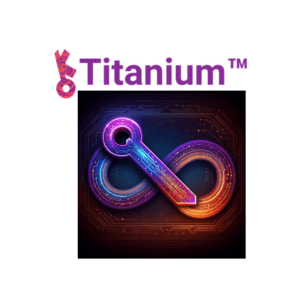
sonKsuru Titanium™ Engine: A New Era in Perfect Secrecy
The study demonstrates the effectiveness, robustness, and innovative AI capabilities of the sonKsuru Titanium™ Engine in encryption tasks for creating perfect secrecy.
Empowering Everyone with Perfect Secrecy
Empowering Everyone with Perfect Secrecy

Founding Scientist, Chief Scientific Officer
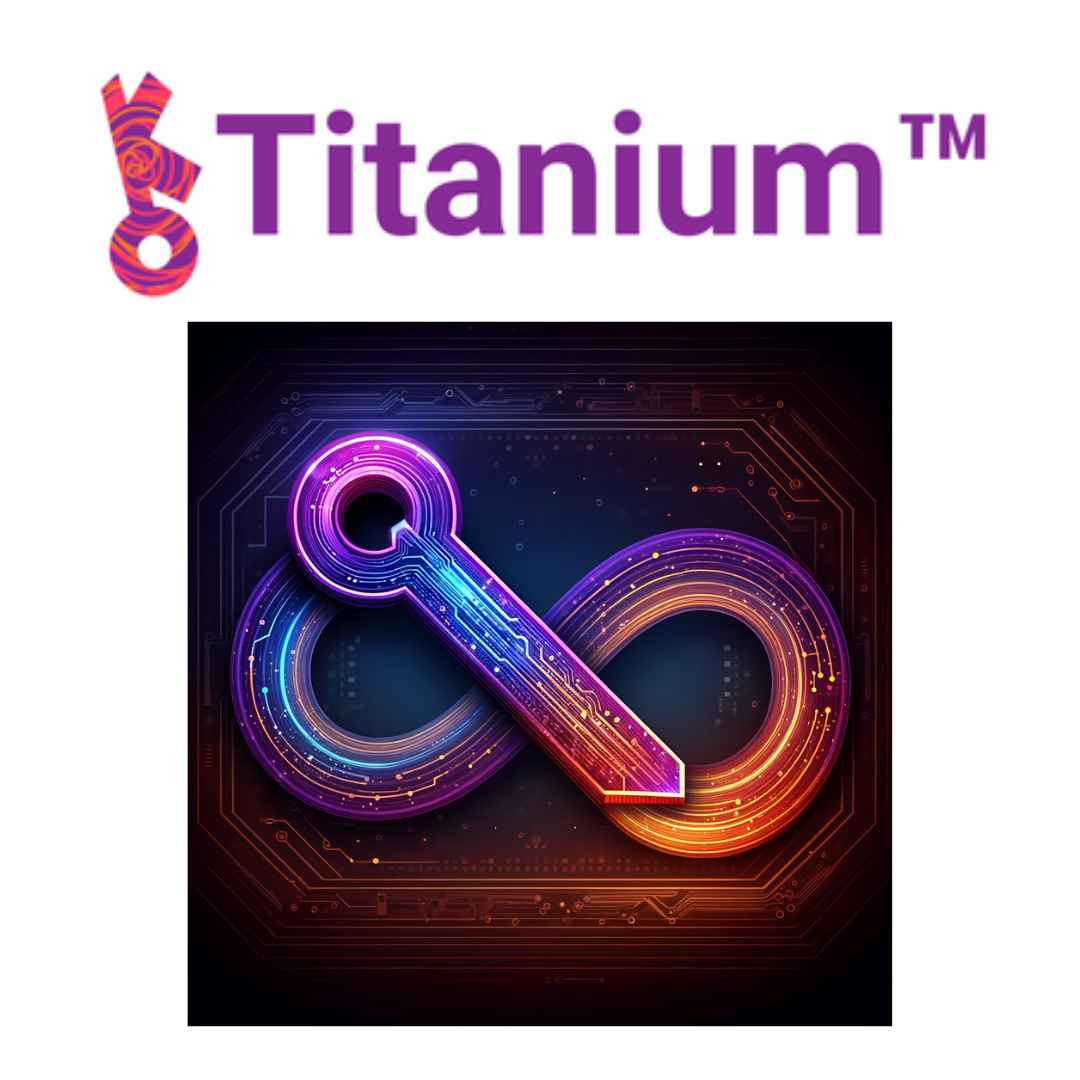
Date of Test: 12-12-2023, 1:27 p.m. est. Research Testers: Greg Peatfield, Tracy Levine, and Mike Johnson
Background: The sonKsuru Titanium™ Engine, an advanced encryption system, was evaluated for its key length, randomness, and AI capabilities. The engine uses a key length greater than the plaintext length in its most streamlined configuration, with some configurations having a key length up to ten times the plaintext length.
Objective: The objective of this study was to evaluate the key length, randomness, and AI capabilities of the sonKsuru Titanium™ Engine. This was demonstrated using the nursery rhyme “Mary Had a Little Lamb” as a test input. The Shannon Entropy method was used to assess the randomness of the keys.
Methods: The engine’s AI component not only generates new keys but also new algorithms for each subsequent encryption request, implementing a more advanced version of the One-Time-Pad. This allows multiple inputs to be combined into the same output stream, contributing to perfect secrecy. The engine was further tested by encrypting the same input file eight times, with visual examination showing significant differences between each encrypted sample.
Results: Importantly, these samples can be returned back to the original plaintext without the need to store or match a decryption key/pad with each ciphertext output, eliminating the need for transmitting and maintaining keys/pads. The engine was also tested by encrypting the novel “Moby Dick,” with the entropy of the input and output files calculated. The results showed that the engine effectively obfuscated the ASCII input file.
Conclusions: The study demonstrates the effectiveness, robustness, and innovative AI capabilities of the sonKsuru Titanium™ Engine in encryption tasks for creating perfect secrecy.
In the realm of encryption, achieving perfect secrecy is the holy grail. This concept, defined by Claude Shannon in 1948, stipulates that a ciphertext should reveal no information about the original plaintext without knowledge of the key. Even with unlimited computational resources, an attacker should not be able to glean any information from the ciphertext alone.
One of the critical aspects of achieving perfect secrecy is the key used for encryption. According to Shannon, this key must be as long as the message itself, completely random, and never reused. This principle forms the basis of the One-Time-Pad encryption technique, which stipulates that the key must be at least as long as the plaintext message, truly random, uniformly distributed in the set of all possible keys, independent of the plaintext, and never reused in whole or in part. Moreover, the key must be kept completely secret by the communicating parties.
In this paper, we evaluate the sonKsuru Titanium™ Engine, an advanced encryption system that not only adheres to these principles but also introduces innovative AI capabilities. The engine uses a key length greater than the plaintext length in its most streamlined configuration, with some configurations having a key length up to ten times the plaintext length. The engine’s AI component generates new keys and new algorithms for each subsequent encryption request, implementing a more advanced version of the One-Time-Pad. This allows multiple inputs to be combined into the same output stream, contributing to perfect secrecy.
The effectiveness of the sonKsuru Titanium™ Engine is demonstrated through various tests, including the encryption of the nursery rhyme “Mary Had a Little Lamb” and the novel “Moby Dick”. The results show that the engine effectively obfuscates the ASCII input file and eliminates the need for transmitting and maintaining keys/pads. This paper provides a comprehensive evaluation of the sonKsuru Titanium™ Engine, showcasing its unique approach to encryption tasks and highlighting its potential to redefine the landscape of secure communication.
sonKsuru TitaniumTM Engine uses a key length greater than the length of the plaintext being encrypted in its lowest stream-lined configuration. In some configurations, the key length can be upwards to ten times the plaintext length. This can be seen in the following test example. We took the child’s nursery rhyme “Mary Had a Little Lamb” in its plain text format as a test input for encryption. The text byte values were exported to a CSV file for import into a spreadsheet.
This data can be seen in Figure 1 below and looks like a classic ASCII text data file.
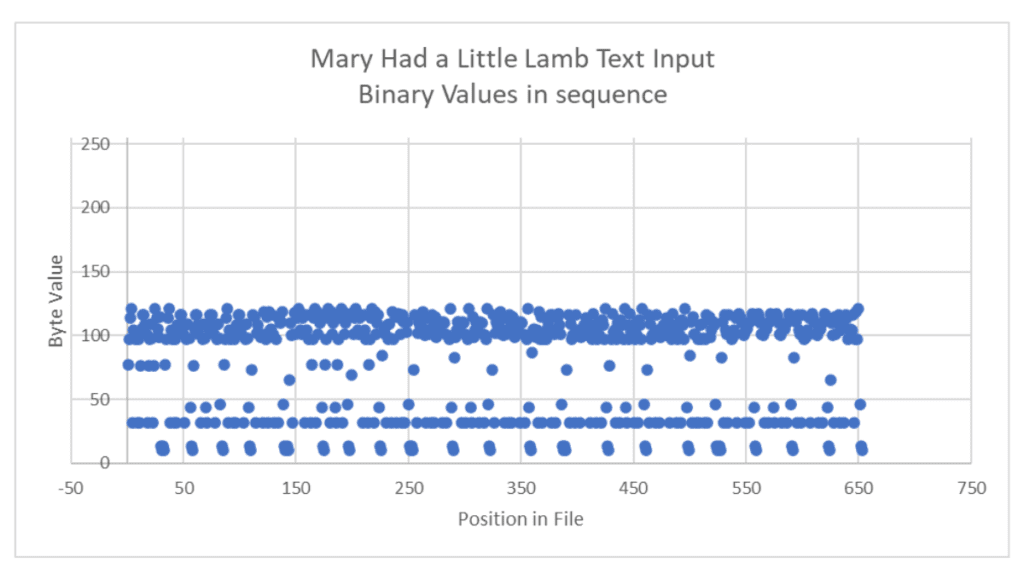
It is 653 bytes in length as stored on the hard drive. The bulk of the values are lower-case letters from ascii 97 to 122. The infrequent upper-case letters for proper nouns and starts of sentences range from 65 to 90. There is an almost solid line on the graph at 32, this is the ASCII spacebar character between words. Below that is the “Carriage Return/Linefeed,” which Windows-based computers add to the end of a line to start a new text row. These are the dots at the bottom made up of 13 & 10. There are a few punctuation and number symbols thrown in as well. For a complete list, search for “ASCII Table” online. The key length for the encrypted ciphertext turned out to be 736 bytes. Longer than the white text input length.
Random keys are essential to the perfect secrecy of the TitaniumTM Engine. Given the internal functions of the platform, the best way to demonstrate the randomness of the keys is to use Shannon Entropy for the digital data. A good description of this calculation can be found here: (https://rosettacode.org/wiki/Entropy, https://en.wikipedia.org/wiki/Entropy_(information_theory) ). In short, this is based on information theory and a way to measure how random data looks or how much information is in it. It reports the number of bits required to reflect the presented data set. Since the input is 8-bit bytes, a Shannon Entropy of 8 is completely random. Numbers less than 8 imply some structure to the data since some bits are not needed to represent the data.
sonKsuru tested the Shannon Entropy of encrypting the public domain novel “Moby Dick” which was downloaded from The Gutenberg Project (https://www.gutenberg.org/cache/epub/2701/pg2701.txt). The file is 1,276,366 bytes in length, consisting of the ASCII text of the book, and is large enough to expose any encryption limitations. The book was encrypted by the TitaniumTM engine with its standard settings, which include corruption detection, and the output ciphertext is 1,285,002 bytes long. The frequency of occurrence of all the input and output bytes were calculated and shown below in Figure 2.
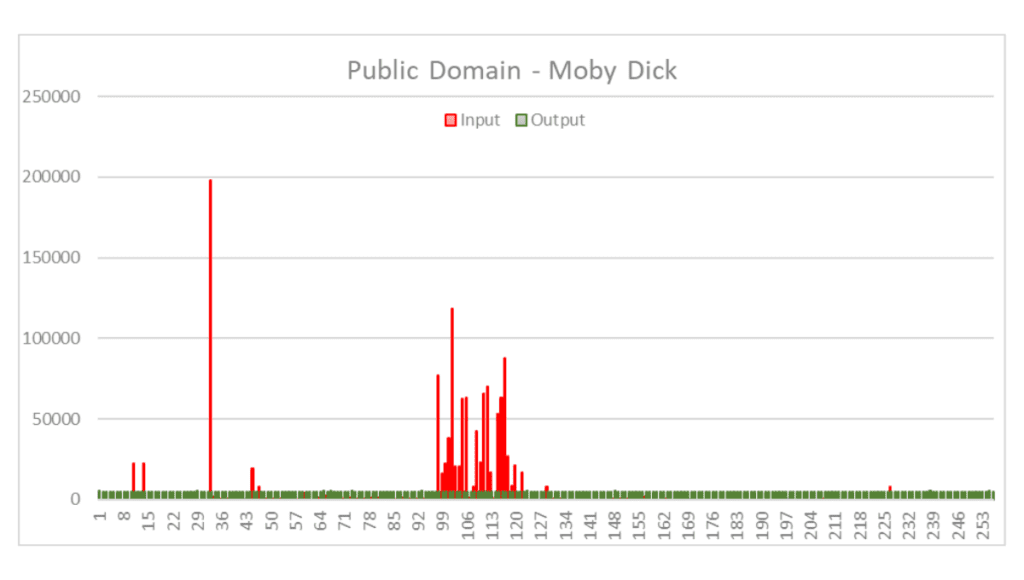
The chart visualizes the occurrence of bytes in each file. Red being the ASCII input file and green being the ciphertext output file. It is immediately apparent that the red spikes of the input file have been flattened out in the ciphertext showing the contents of the ASCII file have been well obfuscated. This same data was used to calculate the Shannon Entropy of both the plaintext input file as well as the ciphertext output file. The entropy for the input was about 5 bits (4.5984 bits) and the output was almost perfect at 8 bits (7.9998 bits). The random pad/key used by the TitaniumTM Engine generates a near perfect random distribution from ASCII based organized input.
The AI brain with the TitaniumTM Engine generates not only new keys but also new algorithms for each subsequent encryption request. sonKsuru implements a more advanced version of the One-Time-Pad, so it internally develops multiple keys for different features/aspects, making up the output Z perfect secrecy. sonKsuru’s patent-pending technology allows multiple inputs X to be combined into the same output stream Z. This is possible due to the novel solution, which eliminates the need to transmit or record the pad/keys Y. The generalized formula for the sonKsuru technology is:

The same input file, “Mary Had a Little Lamb,” discussed above, was encrypted 8 times to demonstrate the AI feature of creating a new encryption for each subsequent run. The data was exported again to visualize the byte values of each file. Figure 3 shows those visuals around the outer edge of the 3×3 grid; the center of the grid is the plaintext input file for easier comparison. Visual examination shows that each of the 8 encrypted samples are significantly different from one another.

The other part to remember is that these 8 encrypted samples can be returned back to original plain text without the need to store or match a decryption key/pad with each ciphertext output. The sonKsuru Titanium™ Engine was designed to eliminate the need for transmitting and maintaining keys/pads. By design, the key/pad is also secret and never transmitted from endpoint to endpoint.
The study demonstrates the effectiveness, robustness, and innovative AI capabilities of the sonKsuru Titanium™ Engine in encryption tasks for creating perfect secrecy.

The study demonstrates the effectiveness, robustness, and innovative AI capabilities of the sonKsuru Titanium™ Engine in encryption tasks for creating perfect secrecy.
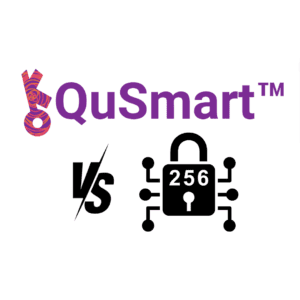
sonKsuru’s Titanium™ Engine: A Quantum-Proof, Keyless System Outperforming AES 256 and 143% / 1.43X faster.